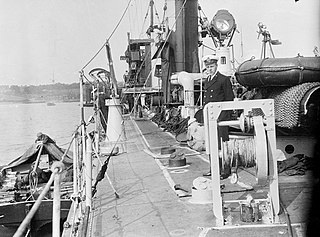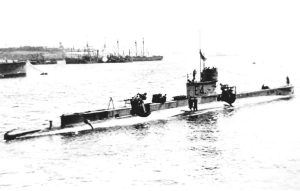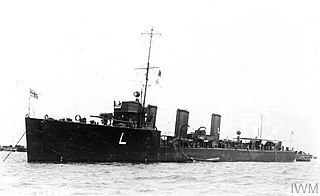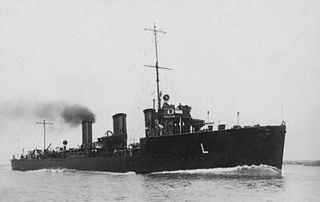
HMS Laforey was the lead ship of her class of destroyer built for the Royal Navy. Launched a year before the First World War began, she was attached to the Dover Patrol. Laforey saw action in several engagements with German torpedo boats, including the Battle off Noordhinder Bank and the action of 17 March 1917. Laforey was sunk in 1917 by a British mine after escorting several freighters to France. She was named for Francis Laforey, captain of HMS Spartiate at the Battle of Trafalgar in 1805.

HMS E4 was a British E class submarine built by Vickers, Barrow-in-Furness, costing £101,900. E4 was laid down on 16 May 1911, launched on 5 February 1912 and commissioned on 28 January 1913. On 24 September 1915 E4 was attacked by the German airship SL3. On 15 August 1916, she collided with sister ship E41 during exercises off Harwich. Both ships sank and there were only 14 survivors, all from E41. Both boats were raised, repaired and recommissioned. She was sold on 21 February 1922 to the Upnor Ship Breaking Company.

HMS Defender was an Acheron-class destroyer which was built in 1911, served throughout World War I and was broken up in 1921. She was the fifth ship of the name to serve in the Royal Navy.

HMS Lennox was a Laforey-class destroyer built for the Royal Navy during the 1910s.
HMS Laverock was a Laforey-class destroyer of the Royal Navy. She was launched in 1913 and entered service in October 1914. Laverock served through the First World War, operating with the Harwich Force and in the English Channel. She was sold for scrap in 1921.

HMS Landrail was a Laforey-class destroyer of the British Royal Navy. The Laforey class was the class of destroyers ordered under the Royal Navy's 1912–1913 construction programme, which were armed with three 4-inch (102 mm) guns and four torpedo tubes and were capable of 29 knots. The ship, which was originally to be named Hotspur but was renamed before launch, was built by the Scottish shipbuilder Yarrow between 1912 and 1914,
HMS Lark was a Laforey-class destroyer of the British Royal Navy. The Laforey class was the class of destroyers ordered under the Royal Navy's 1912–1913 construction programme, which were armed with three 4-inch (102 mm) guns and four torpedo tubes and were capable of 29 knots. The ship, which was originally to be named Haughty but was renamed before launch, was built by the Scottish shipbuilder Yarrow between 1912 and 1913.

HMS Laurel was a Laforey-class destroyer which served with the Royal Navy. Launched on 6 May 1913 as HMS Redgauntlet, the ship was renamed on 30 September under an Admiralty order to become one of the first alphabetical class destroyers. On commissioning, the vessel joined the 3rd Destroyer Flotilla and operated as part of the Harwich Force during the First World War. During Battle of Heligoland Bight, Laurel led a flotilla that pursued German torpedo boats, engaging with G194 and G196, and was damaged in action with the cruiser Mainz. The vessel also played a minor role in the Battles of Dogger Bank, Dover Strait and Jutland. With the cessation of hostilities, the ship was placed in reserve and scrapped on 1 November 1921.

HMS Liberty was a Laforey-class destroyer that served with the Royal Navy during the First World War. Launched on 15 September 1913 as HMS Rosalind, the ship was renamed on 30 September under an Admiralty order to become one of the first alphabetical class destroyers. On commissioning, the vessel joined the Third Destroyer Flotilla and operated as part of the Harwich Force. During Battle of Heligoland Bight, Liberty engaged with the German torpedo boats G194 and G196, and scored two hits on the cruiser Mainz. On 8 February 1917, the destroyer rammed and sank the German submarine UC-46. The vessel also played a minor role in the battles of Dogger Bank, Dover Strait and Jutland, as well as acting as a convoy escort and patrolling the Dover Barrage. With the cessation of hostilities, the ship was placed in reserve and sold to be broken up on 5 November 1921.

HMS Linnet was a Laforey-class destroyer that served with the Royal Navy during the First World War. Launched on 16 August 1913 as HMS Havock, the ship was renamed on 30 September under an Admiralty order to become one of the first destroyers in a class named alphabetically. This convention subsequently became the norm. On commissioning, the vessel joined the Third Destroyer Flotilla and operated as part of the Harwich Force. The destroyer was first commanded by Commander Loftus Jones who named his daughter Linnette after the ship. During the War, the destroyer took part in the Battle of Heligoland Bight in 1914, and escorted minelayers on missions to lay mines. It was during one the latter missions that the ship was nearly hit by a gun hurled from the stricken minelayer Amphion. With the cessation of hostilities, the ship was placed in reserve and sold to be broken up on 4 November 1921.

HMS Lysander was a Laforey-class destroyer that served with the Royal Navy during the First World War. Launched in August 1913 as HMS Ulysses, the ship was renamed the following month under an Admiralty order to become one of the first in what would be the norm, a class of destroyers named after successive letters of the alphabet. On commissioning, the vessel joined the Third Destroyer Flotilla and operated as part of the Harwich Force. The destroyer took part in the Battle of Heligoland Bight in 1914, attacking the German light cruiser Mainz and escorted the seaplane carriers Engadine and Riviera in an abortive attempt to attack the Cuxhaven airship base. During 1915, Lysander undertook anti-submarine patrols and escorting duties, coming under fire from German shore-based batteries while accompanying the mine-laying paddle-steamers Prince of Wales and Queen Victoria off the coast of Ostend. In 1916, the destroyer was involved in action with German battlecruisers following the bombardment of Yarmouth and Lowestoft but escaped unharmed, and rescued the survivors from the Canadian hospital ship Llandovery Castle in 1918. With the cessation of hostilities, the ship was placed in reserve and sold to be broken up in June 1922.

HMS Medway was a Admiralty M-class destroyer which served with the Royal Navy during the First World War. The M class were an improvement on the previous Laforey-class, capable of higher speed. Originally laid down as HMS Redwing by J. Samuel White at East Cowes on the Isle of Wight, the vessel was renamed before being launched on 8 March 1916. The vessel was allocated to the Grand Fleet and served in the Second Battle of Heligoland Bight in support of the First Light Cruiser Squadron in their action against German light cruisers and minesweepers. During the action, the ship did not record any hits. After the War, the destroyer was placed in reserve and subsequently sold to be broken up on 9 May 1921.

HMS Medina was a Admiralty M-class destroyer which served with the Royal Navy during the First World War. The M class were an improvement on the previous L class, capable of higher speed. Originally laid down as HMS Redmill by J. Samuel White at East Cowes on the Isle of Wight, the vessel was renamed before being launched in 1916. The ship was allocated to the Grand Fleet and spent much of its service in anti-submarine warfare, either escorting convoys or involved in submarine hunting patrols. Although the destroyer attacked a number of German submarines, none were sunk. After the War, Medina was reassigned to a defence flotilla in Portsmouth and was eventually sold to be broken up in 1921.

HMS Lochinvar was a repeat Laforey-class destroyer which served with the Royal Navy during the First World War. Named after the character in the poem Marmion, the ship was originally to be called HMS Malice but was renamed prior to being launched on 9 October 1915. The destroyer joined the Harwich Force and took part in anti-submarine patrols, as well as escorting the monitors Erebus and Terror for their attacks on the canal gates at Zeebrugge and the port of Ostend in 1917. After the Armistice, the vessel was placed in reserve and sold to be broken up on 25 November 1921.

HMS Lawford was a Laforey-class destroyer of the British Royal Navy. The Laforey class was the class of destroyers ordered under the Royal Navy's 1912–1913 construction programme, which were armed with three 4-inch (102 mm) guns and four torpedo tubes and were capable of 29 knots. The ship, which was originally to be named Ivanhoe but was renamed before launch, was built by the Scottish shipbuilder Fairfields between 1912 and 1914.

HMS Pelican was a Admiralty M-class destroyer which served with the Royal Navy during the First World War. The M class were an improvement on the preceding L class, capable of higher speed. Launched on 18 March 1916, the vessel served with the Grand Fleet, taking part in significant actions on 19 August 1916 and 4 May 1917, as well as the fight between the British and German battlecruisers in the Battle of Jutland. The destroyer also undertook the other more general roles were typical of the type, including anti-submarine sweeps and escort duties for convoys. The destroyer had success driving away German submarines but did not sink any. After the end of the war, Pelican initially joined a Local Defence Flotilla but within a year had been placed in reserve and was subsequently sold to be broken up on 9 May 1921.

HMS Penn was a Repeat Admiralty M-class destroyer which served with the Royal Navy during the First World War. The M class were an improvement on the preceding L class, capable of higher speed. The ship was named after William Penn, the father of the founder of Pennsylvania. Launched on 8 April 1916, the vessel served with the Grand Fleet forming part of the screen for the dreadnought battleships of the 1st Battle Squadron and escorting the aircraft carrier Furious in battle. The destroyer participated in the Actions of 19 August 1916 and 16 October 1917, as well as forming part of the distant support during the Second Battle of Heligoland Bight. Penn was also instrumental in rescuing the survivors from the light cruiser Nottingham, sunk by a German submarine. After the Armistice that ended the war, the destroyer was placed in reserve and subsequently sold to be broken up on 9 May 1921.

HMS Lookout was a Laforey-class destroyer that served with the Royal Navy during the First World War. Laid down in 1912 as HMS Dragon, the ship was renamed in 1913 under an Admiralty order to become one of the first alphabetical class destroyers. Launched in 1914, Lookout joined the Harwich Force and participated in the Battle of Heligoland Bight, attacking the German light cruiser Strassburg with torpedoes, and the Battle of Dogger Bank. For much of the war, the ship acted as an escort for a wide range of ships, including the troopships carrying soldiers to serve in the Gallipoli campaign and the seaplane carriers Riviera and Vindex during an attack on the Zeppelin hangars at Zeebrugge. From 1917, the destroyer served as an escort to convoys of merchant ships. At the end of the war, the warship was placed in reserve. Although subsequently offered for sale to the Finnish Navy, Lookout was instead withdrawn from service and sold to be broken up in 1922.

HMS Mansfield was a Hawthorn Leslie M-class destroyer that served in the Royal Navy during the First World War. The M class was an improvement on those of the preceding L class, capable of higher speed. Built by the Tyneside shipbuilder Hawthorn Leslie, the destroyer was launched in 1915 and joined the Harwich Force as an anti-submarine escort for merchant ships in the Southwest Approaches and English Channel. In between that service, in 1916, Mansfield accompanied the seaplane carrier Vindex on a seaplane raid on German Zeppelin sheds during which the destroyer assisted in the sinking of two German patrol boats. In 1918, the vessel supported attacks by British monitors and submarines against Zeebrugge and escorted Vindictive to Ostend where the retired protected cruiser was sunk as a blockship. After the Armistice, Mansfield was placed in reserve before being sold to be broken up in 1921.

HMS Prince was a Repeat Admiralty M-class destroyer that served in the Royal Navy during the First World War. The M class was an improvement on those of the preceding L class, capable of higher speed. Launched in 1916, Prince joined the Twelfth Destroyer Flotilla of the Grand Fleet. The destroyer assisted in the rescue of the crew of the flotilla leader Hoste in 1916, laying down fuel oil on the sea in an attempt to create a calm enough environment to evacuate the sinking ship. The operation was successful and all the sailors were saved. In 1917, the ship formed part of the destroyer screen for the First Battle Squadron during the Second Battle of Heligoland Bight but saw no action. After the Armistice that ended the war, Prince was initially put in reserve and then sold in 1921 to be broken up.














